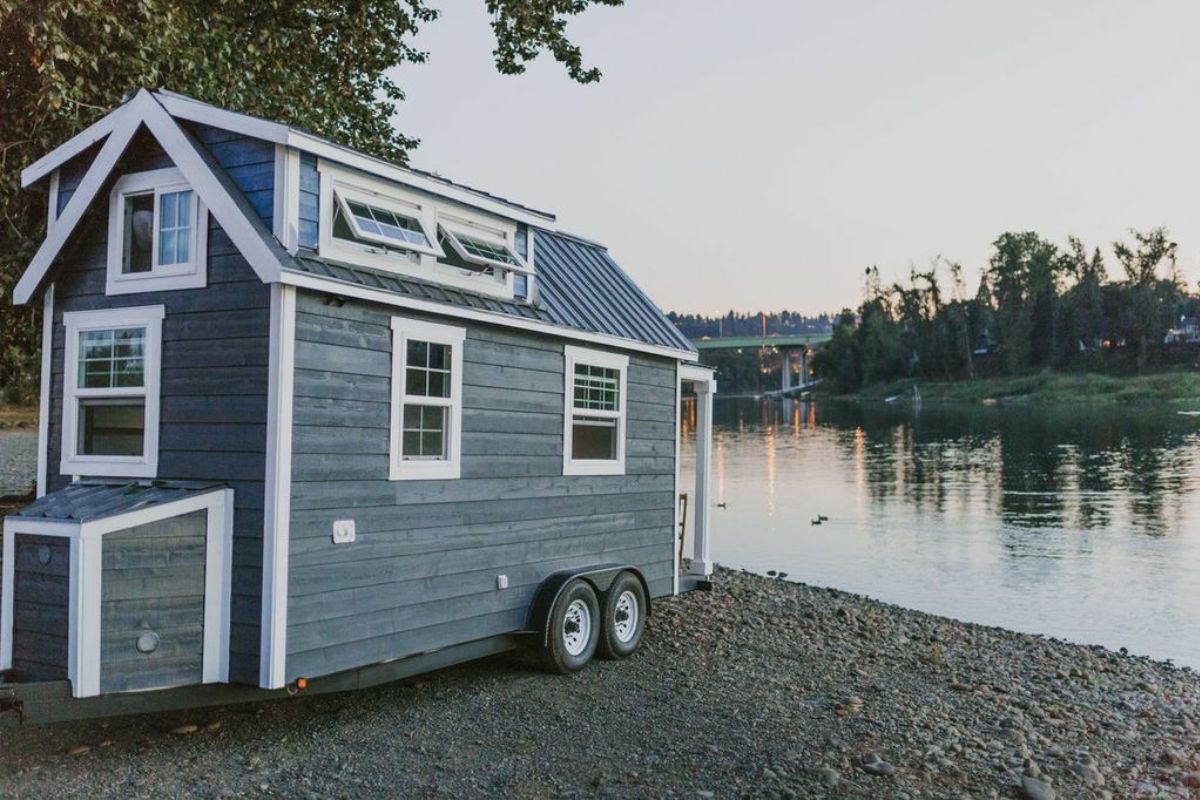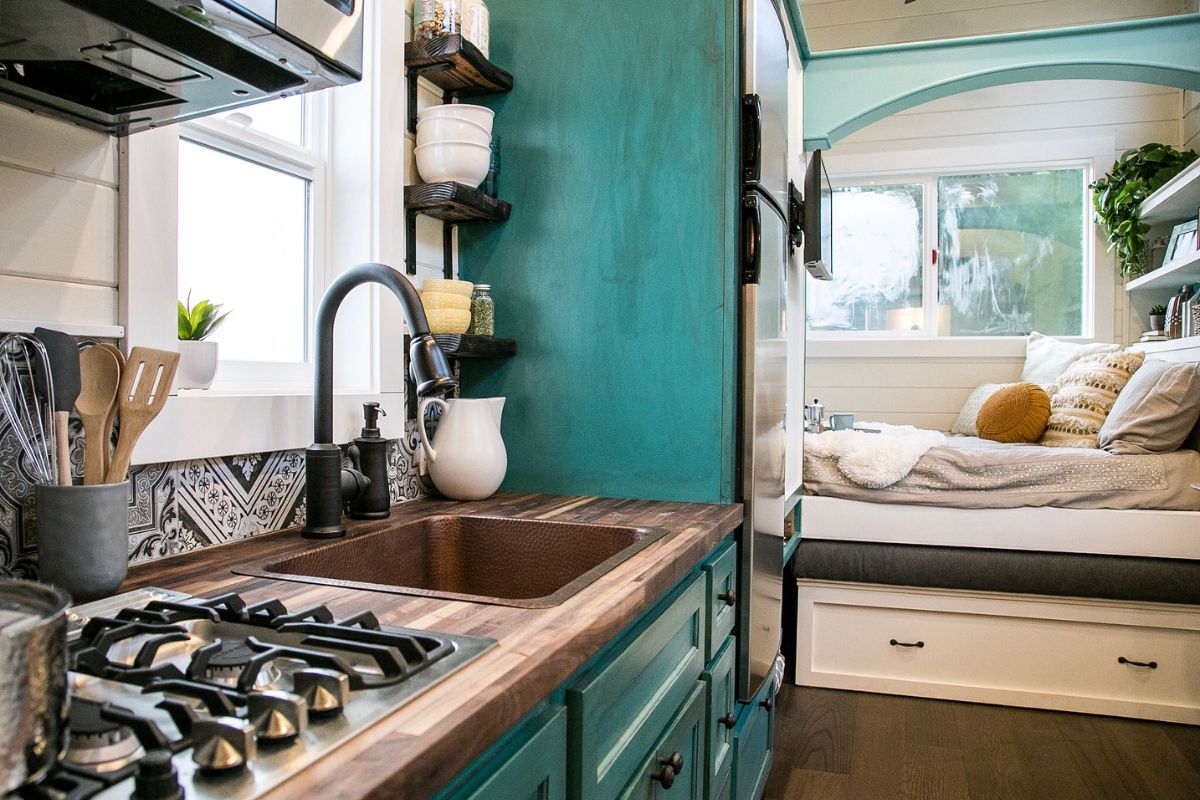Protect a tiny home by controlling moisture at the source and in the assembly. Quantify interior loads; monitor RH and dew point. Build a continuous WRB and airtight layer; lap shingle-style and pressure-test. Use compatible membranes, tapes, and MSP/polyurethane sealants.
Pan, tape, and flash windows/doors correctly; seal roofs and penetrations. Provide balanced ventilation, right-sized insulation, drainage planes, and capillary breaks. Maintain gutters, flashings, and sealants on schedule. These steps prevent leaks, rot, and condensation—and there’s more you can do.
Key Takeaways
-
Control interior moisture with continuous ventilation, exhaust fans at kitchen/bath, and hygrometers; keep indoor RH near 30–50% to avoid condensation.
-
Build a continuous water-resistive and air barrier; shingle-lap WRB, seal penetrations, and blower-door test to verify airtightness.
-
Choose compatible membranes, tapes, and sealants; prefer acrylic/butyl tapes and MSP/polyurethane sealants, following one manufacturer’s system.
-
Flash windows and doors correctly: sloped sill pan, self-adhered membranes, head flashing with end dams, and shingle-fashion taping at jambs and head.
-
Maintain seasonally: inspect roof edges, gutters, flashings, and sealants; clean vents, test dampers, recoat exposed membranes, and document repairs.
Understanding Moisture Sources in Tiny Homes
Two primary pathways drive moisture problems in tiny homes: water you bring in and water that forces its way in. You add liquid and vapor through cooking, bathing, breathing, plants, and wet gear. In tight tiny homes, these interior moisture sources can spike relative humidity fast, leading to condensation on cold surfaces.
Outside, rain, snowmelt, wind-driven spray, capillary wicking, and bulk leaks at penetrations add load. Don’t forget seasonal vapor drives: warm-to-cold in winter, exterior-to-interior in humid summers. Track sources by quantifying occupancy, shower duration, combustion appliances, and infiltration rates.
Use hygrometers to log RH and temperature; compare to dew point to predict risk at known thermal bridges. Classify each source as vapor, bulk water, or capillary so you can target controls efficiently.

Creating a Continuous Water and Air Barrier
Now that you’ve mapped where moisture originates, you can block its paths with a continuous water-resistive barrier (WRB) and air barrier that align at every plane, seam, and penetration. Treat the tiny home shell as one interconnected control layer. Lap WRB shingle-style, drain outward, and maintain positive laps at corners, junctions, and openings. Wrap rough openings, integrate head flashings with the WRB, and connect wall, roof, and floor WRBs without gaps.
Use air barrier techniques that define a clear primary air layer—often sheathing or interior gypsum—and verify continuity at rim joists, utility chases, and loft interfaces. Seal changes in materials with compatible connections. Prioritize water barrier strategies that provide drainage, drying paths, and capillary breaks. Pressure-test the enclosure (blower door) to confirm target leakage rates per local energy code.
Choosing the Right Membranes, Tapes, and Sealants
Although many products can keep bulk water out, you’ll get durable performance only by selecting membranes, tapes, and sealants that are compatible with each other and with your substrates. Match membrane types to climate and assembly: use vapor-open WRBs for mixed/humid zones, self-adhered bituminous membranes for high-exposure areas, and fully-adhered vapor-impermeable layers only where drying paths remain. Verify ICC-ES reports, perm ratings, nail-sealability, UV exposure limits, and service temperatures.
Choose tapes tested with the membrane—acrylic for cold tack and longevity, butyl for aggressive adhesion to metals and plastics. Clean, dry, and roll to specified pressure. For sealant applications, use high-quality MSP or polyurethane; avoid silicone where paint or later adhesion is required. Follow manufacturer systems and warranty requirements to maintain code compliance.

Detailing Windows, Doors, and Flashings
With compatible membranes, tapes, and sealants selected, you can execute window, door, and flashing details that keep bulk water out and preserve drying paths. Begin window installation with a sloped sill pan: self-adhered membrane over a backdam, shingle-lapped onto the WRB. Set spacers, apply sealant to jambs and head (not the sill), then place the unit plumb and square.
Tape jambs and head in shingle fashion; leave the sill able to drain. Add head flashing that extends past the jambs with end dams. Integrate all flashings behind cladding but over the WRB.
For doors, use the same pan method and backer-rod-and-sealant joint design. Prioritize air control at the interior, water control at the exterior. Verify clearances, weeps, and door sealing per manufacturer instructions and applicable code.
Sealing Roofs, Vents, and Penetrations
Because roofs collect and shed the most water, you must detail every seam, fastener, and penetration to the same standard as eaves and changes. Select roof materials compatible with your membrane and sealants; confirm manufacturer instructions and IRC/IBC requirements for slope, underlayment, and fastener patterns. Use a continuous self-adhered underlayment at eaves, valleys, and penetrations. Lap upslope over downslope, 6 inches minimum, and roll firmly.
At vents, flues, and skylights, install factory flashings over the finished roofing, not under it, unless the system specifies integrated pans. Bed flanges in butyl, not silicone, and mechanically fasten into framing, not sheathing alone. Cap fasteners with compatible sealant. For corrugated panels, use closure strips and neoprene-gasketed screws. Maintain clearance at hot flues; use listed high-temp boots and storm collars.
Managing Condensation With Ventilation and Insulation
Tight roof details keep bulk water out, but moisture still forms inside from cooking, bathing, and breathing, and it will condense on cold surfaces if you don’t control temperature and vapor movement. Manage indoor humidity first: target 30–50% RH, verified with a hygrometer. Use balanced ventilation strategies—ideally a small HRV/ERV sized to ASHRAE 62.2, with continuous low-flow and boost switches in bath and over the cooktop. Duct exhausts outdoors.
Select insulation materials that keep interior surfaces warm and control diffusion. In cold climates, use exterior continuous insulation to reduce thermal bridging and place the primary air barrier inward of the dew point. Employ smart vapor retarders (Class II/III) on the warm-in-winter side. Seal all joints, can lights, and chases. Commission with blower-door testing and verify airflow.

Designing Drainage Planes and Capillary Breaks
Even when you’ve nailed air and vapor control, bulk water will still try to get in, so you need a dedicated drainage plane and reliable capillary breaks to move it out and keep it from wicking. Use a continuous WRB over sheathing with shingled laps, taped seams, and 3/8–3/4 inch rainscreen furring to create a ventilated cavity—this is core drainage plane design.
Flash openings with sloped sills, end dams, and positive laps. Provide weeps at the base and above windows. Integrate kick-out flashing at roof-wall junctions. For capillary break techniques, isolate wood from concrete with sill gaskets or peel-and-stick membranes, use double WRBs behind absorptive claddings, and specify capillary-closed materials. Follow IRC/IBC water-resistive barrier and flashing requirements for assemblies and penetrations.
Routine Inspections and Maintenance for Long-Term Protection
A well-detailed drainage plane and capillary breaks only work if you keep them clear, intact, and continuous. Build a plan around routine checks and maintenance schedules tied to seasons. Each quarter, inspect roof edges, gutters, downspouts, and splash blocks; confirm free discharge away from the trailer frame per IRC R801 and local stormwater rules. Verify WRB terminations, flashing laps, and sealant joints; renew failed beads. Probe siding, trim, and penetrations for soft spots or swollen fasteners.
Biannually, clean vents, service fan backdraft dampers, and confirm 50–60% RH max with a hygrometer. Test GFCI-protected heat cable circuits on exposed pipes. Annually, recoat exposed membranes to manufacturer specs, check trailer rust protection, and tighten mechanical fasteners. Document findings, photos, and corrective actions to track deterioration trends.
Conclusion
You’ve now mapped moisture sources, built continuous air/water barriers, and selected code-compliant membranes, tapes, and sealants. Detail every penetration—windows, doors, flashings, roofs, and vents—with shingle-lapped layers and manufacturer-listed components. Control condensation with balanced ventilation (per ASHRAE 62.2), correct insulation ratios, and smart vapor control.
Add drainage planes and capillary breaks to redirect bulk water. Finally, inspect seasonally, renew sealants, verify fastening/adhesion, and document repairs. Do this, and your tiny home stays dry, durable, and code-aligned.






Share: